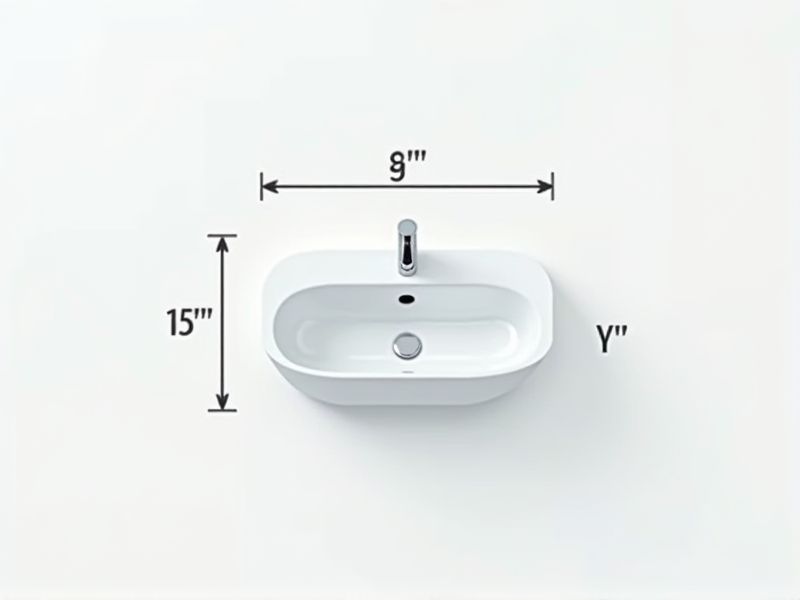
When selecting a bathroom sink, it's helpful to know that standard dimensions typically range from 16 to 20 inches in diameter for round sinks, and about 19 to 24 inches wide by 16 to 23 inches front-to-back for rectangular sinks. Depth usually falls between 5 and 8 inches, allowing for comfortable use without excessive splashing. Knowing these measurements can help you choose a sink that fits well with your vanity and the overall bathroom layout. Always measure your available space carefully to ensure the sink you select will be both functional and visually pleasing in your bathroom.
Width
The standard width for a bathroom sink typically ranges from 20 to 24 inches, ensuring compatibility with various vanity sizes. A sink width of 22 inches often provides a balanced space that accommodates daily tasks while offering ample countertop area. If you're considering a smaller bathroom, compact sinks around 18 inches may efficiently optimize limited space without sacrificing functionality. For larger bathrooms, a width of 25 inches or more can provide a luxurious, spacious feel and enhance your overall design aesthetic.
Depth
The standard depth of a bathroom sink typically ranges from 5 to 8 inches, balancing functionality with aesthetics. A depth of 7 inches is often preferred as it provides ample space to prevent splashing while ensuring convenient use for handwashing and grooming tasks. When selecting your sink, consider how a deeper basin can enhance comfort, especially for taller users or those with larger hands. Choosing the right depth helps optimize user experience while maintaining a stylish appearance in your bathroom design.
Height
The standard height for a bathroom sink typically ranges from 32 to 36 inches (81 to 91 centimeters) above the finished floor. This height accommodates the average adult's comfort, allowing for ease of use when washing hands or brushing teeth. For children or smaller users, consider a lower height of around 30 inches (76 centimeters) to ensure accessibility. You may also opt for adjustable-height sinks to cater to different user needs and preferences.
Basin Size
The standard bathroom sink basin size typically ranges from 16 to 20 inches in width and 12 to 16 inches in depth. For optimal functionality, a depth of at least 5 to 8 inches is recommended to prevent splashing while allowing ample space for washing hands. When selecting a sink, consider the available counter space and the overall dimensions of your bathroom, as a sink that is too large can disrupt balance. A well-proportioned sink enhances both aesthetics and usability, ensuring a harmonious integration into your bathroom design.
Drain Hole Size
The standard drain hole size for bathroom sinks typically measures 1.25 inches in diameter. This dimension accommodates most common drain sizes, ensuring effective water drainage while preventing clogs. It's essential to select a sink that aligns with this standard to simplify installation and enhance plumbing efficiency. If you're considering a bathroom remodel, verifying your sink's drain hole size can prevent costly adjustments down the line.
Faucet Hole Spacing
The standard faucet hole spacing for bathroom sinks typically ranges from 4 inches to 8 inches, catering to various faucet designs and installations. For centerset faucets, a common configuration is a 4-inch spacing, allowing for easier installation with a single mounting plate. On the other hand, widespread faucets often require an 8-inch spacing, providing more flexibility in terms of aesthetics and functionality. When choosing a sink, consider your faucet's specifications to ensure compatibility and optimal performance.
Countertop Thickness
The standard countertop thickness for bathroom sinks typically ranges from 1 to 2 inches, providing a robust surface that can withstand daily use. Countertops with a thickness of 1.5 inches are particularly popular, offering a balance of durability and aesthetic appeal. When selecting a sink, consider materials like granite, quartz, or solid surface, as they affect the overall weight and required support of the countertop. Your choice of thickness can also impact the installation process, with thicker countertops often needing more precise support structures for stability.
Mounting Style
The mounting style of a bathroom sink significantly influences both aesthetics and functionality, with common options including drop-in, undermount, pedestal, and wall-mounted designs. Drop-in sinks typically feature a rim that rests on the countertop, providing easy installation and a traditional look, while undermount sinks offer a seamless appearance by being installed below the countertop. Pedestal sinks, often used in smaller spaces, feature a freestanding base that supports the sink without the need for additional cabinetry. Wall-mounted sinks save floor space and create a modern, minimalist vibe, making them ideal for contemporary bathroom designs.
Overflow Capacity
A standard bathroom sink typically features an overflow capacity that prevents water from spilling over the edge, enhancing safety and usability. This overflow system is designed with a drain hole located near the top of the sink basin, allowing excess water to escape before it reaches critical levels. Most overflow drains can accommodate an additional 3-4 liters of water, significantly reducing the risk of flooding in your bathroom. Ensuring your sink has a properly functioning overflow mechanism can protect your home from water damage and promote a hassle-free experience.
Material Thickness
Material thickness in bathroom sinks typically ranges from 0.5 mm to 3 mm, with thicker materials providing enhanced durability and resistance to damage. Sinks made from stainless steel feature a thickness of approximately 1 mm to 1.2 mm, ensuring a balance between strength and weight. Ceramic sinks usually measure around 8 mm to 12 mm thick, offering a robust surface that is also visually appealing. When choosing a sink, consider that a thicker material can improve longevity and reduce maintenance issues, making it a worthwhile investment for your bathroom.
